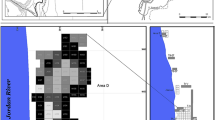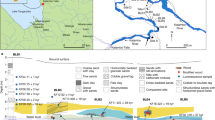Abstract
As known, artefacts made from wood are very rarely encountered in prehistoric deposits due to the low durability of this material. Emergency excavations in the spring of 2012 at Poggetti Vecchi, Central Italy, brought to light an open-air, stratified Palaeolithic site of an overall area of around 160 m2. The finds are radiometrically dated to the late Middle Pleistocene. The site is therefore of particular interest, not only because it offers snapshots of the local environment at a time when early Neanderthals occupied the area but also in view of the recovery of wooden tools. The presence of a burnt film on some of the artefacts has led us to conjecture that, in addition to stone tools, fire was also used in the manufacture of the sticks, as documented in ethnography and hypothesised for prehistoric digging sticks. An experimental study was carried out to reconstruct the operational chain of this kind of tool. This study demonstrates that the use of fire was functional to the manufacture of the sticks featuring this morphology. The working of a very hard wood like Buxus is painstaking and requires a complex operational chain, from the selection of the particular wood to its working employing stone tools and fire, with a significant investment of time and effort.






Similar content being viewed by others
References
Aldeias, V., Goldberg, P., Sandgathe, D., Berna, F., Dibble, H. L., McPherron, S. P., Turq, A., & Rezek, Z. (2012). Evidence for Neandertal use of fire at Roc de Marsal (France). Journal of Archaeological Science, 39, 2414–2423.
Aranguren, B., Revedin, A., Amico, N., Cavulli, F., Giachi, G., Grimaldi, S., Macchioni, N., & Santaniello, F. (2018). Wooden tools and fire technology in the early Neanderthal site of Poggetti Vecchi (Italy). Proceedings of the National Academy of Sciences, 115(9), 2054–2059. https://doi.org/10.1073/pnas.1716068115.
Aranguren, B., Grimaldi, S., Benvenuti, M., Capalbo, C., Cavanna, F., Cavulli, F., Ciani, F., Comencini, G., Giuliani, C., Grandinetti, G., Mariotti Lippi, M., Masini, F., Mazza, P. P. A., Pallecchi, P., Santaniello, F., Savorelli, A., & Revedin, A. (2019). Poggetti Vecchi (Tuscany, Italy): a late Middle Pleistocene case of human-elephant interaction. Journal of Human Evolution, 133, 32–60.
Benvenuti, M., Bahain, J.-J., Capalbo, C., Capretti, C., Ciani, F., D’Amico, C., Esu, D., Giachi, G., Giuliani, C., Gliozzi, E., Lazzeri, S., Macchioni, N., Mariotti, Lippi, M., Masini, F., Mazza, P. P. A., Pallecchi, P., Revedin, A., Savorelli, A., Spadi, M., Sozzi, L., Vietti, A., Voltaggio, M., & Aranguren, B. (2017). Paleoenvironmental context of the early Neanderthals of Poggetti Vecchi for the late middle Pleistocene of Central Italy. Quaternary Research, 88(2), 327–344. https://doi.org/10.1017/qua.2017.51.
Brown, K. S., Marean, C. W., Herries, A. I. R., Jacobs, Z., Tribolo, C., Braun, D., Roberts, D. L., Meyer, M. C., & Bernatchez, J. (2009). Fire as an Engineering Tool of Early Modern Humans. Science, 325(5942), 859–862. https://doi.org/10.1126/science.1175028.
Capalbo, C., Mazza, P. P. A., Masini, F., Savorelli, A. (2018). Palaeoecology and taphonomy of the straight-tusked elephant late Middle Pleistocene site of Poggetti Vecchi (Southern Tuscany, Italy). In: A. Bertini, M.R. Palombo (Eds.), Quaternary: past, present, future. Alpine and Mediterranean Quaternary 31 (AIQUA Conference, Florence, June 13-14, 2018), pp 43–48.
Goldberg, P., Miller, C. E., & Mentzer, S. M. (2017). Recognizing fire in the Paleolithic archaeological record. Current Anthropology, 58, 175–190.
Gowlett, J. A. J., Brink, J. S., Caris, A., Hoare, S., & Rucina, S. M. (2017). Evidence of burning from bushfires in southern and east Africa and its relevance to hominin evolution. Current Anthropology, 58, 206–216.
Haidle, M. N. (2014). Building a bridge - an archeologist's perspective on the evolution of causal cognition. Front Psychol, 5, 1472. https://doi.org/10.3389/fpsyg.2014.01472.
Hlubik, S., Berna, F., Feibel, C., Braun, D., & Harris, J. W. K. (2017). Researching the nature of fire at 1.5 Mya on the site of FxJj20 AB, Koobi Fora, Kenya, using high-resolution spatial analysis and FTIR spectrometry. Current Anthropology, 58, 243–257.
James, S. R. (1989). Hominid use of fire in the Lower and Middle Pleistocene: a review of the evidence. Current Anthropology, 30, 1–26.
Jaubert, J., Verheyden, S., Genty, D., Soulier, M., Cheng, H., Blamart, D., Burlet, C., Camus, H., Delaby, S., Deldicque, D., Edwards, R. L., Ferrier, C., Lacrampe-Cuyaubère, F., Lévêque, F., Maksud, F., Mora, P., Muth, X., Régnier, E., Rouzaud, J.-N., & Santos, F. (2016). Early Neanderthal constructions deep in Bruniquel Cave in southwestern France. Nature, 534, 111–115.
Karkanas, P., Shahack-Gross, R., Ayalon, A., Bar-Matthews, M., Barkai, R., Frumkin, A., Gopher, A., & Stiner, M. C. (2007). Evidence for habitual use of fire at the end of the Lower Paleolithic: site-formation processes at Qesem Cave, Israel. J Human Evol, 53(2), 197–212.
Koller, J., Baumer, U., & Mania, D. (2001). High-tech in the middle Palaeolithic: Neandertal-manufactured pitch identified. European Journal of Archaeology, 4(3), 385–397. https://doi.org/10.1179/eja.2001.4.3.385.
Lebreton, V., Bertini, A., Russo Ermolli, E., Stirparo, C., Orain, R., Vivarelli, M., Combourieu-Nebout, N., Peretto, C., & Arzarello, M. (2018). Tracing fire in early European prehistory: microcharcoal quantification in geological and archaeological records from Molise (Southern Italy). Journal of Archaeological Method and Theory. https://doi.org/10.1007/s10816-018-9373-3.
Marlowe, F. W. (2010). The Hadza. Hunter-gatherers of Tanzania. University of California Press.
Mazza, P. P. A., Martini, F., Sala, B., Magia, M., Perla Colombini, M., Giachi, G., Landucci, F., Lemorini, C., Modugno, F., & Ribechini, E. (2006). A new Palaeolithic discovery: tar-hafted stone tools in a European Mid-Pleistocene bone-bearing bed. Journal of Archaeological Science, 33, 1310–1318.
Nugent, S. (2006). Applying use-wear and residue analyses to digging sticks. Memoirs of the Queensland Museum, Cultural Heritage Series, 4, 89–105.
Oakley, K. P., Andrews, P., Keeley, L. H., & Clark, J. D. (1977). A reappraisal of the Clacton Spearpoint. Proceedings of the Prehistoric Society, 43, 13–30. https://doi.org/10.1017/S0079497X00010343.
Pawlik, A. F., & Thissen, J. P. (2011). Hafted armatures and multi-component tool design at the Micoquian site of Inden-Altdorf, Germany. Journal of Archaeological Science, 38(7), 1699–1708. https://doi.org/10.1016/j.jas.2011.03.001.
Roebroeks, W., & Villa, P. (2011). On the earliest evidence for habitual use of fire in Europe. Proceedings of the National Academy of Sciences, 108, 5209–5214.
Sandgathe, D. M. (2017). Identifying and describing pattern and process in the evolution of hominin use of fire. Current Anthropology, 58, 360–370.
Sandgathe, D. M., & Berna, F. (2017). Fire and the genus Homo: an introduction to supplement 16. Current Anthropology, 58, 165–174.
Sandgathe, D. M., Dibble, H. L., Goldberg, P., McPherron, S. P., Turq, A., Niven, L., & Hodgkins, J. (2011a). On the role of fire in Neandertal adaptations in Western Europe: Evidence from Pech de l’Azé and Roc de Marsal, France. PaleoAnthropology, 2011, 216–242. https://doi.org/10.4207/PA.2011.ART54.
Sandgathe, D. M., Dibble, H. L., Goldberg, P., McPherron, S. P., Turq, A., Niven, L., & Hodgkins, J. (2011b). Timing of the appearance of habitual fire use. Proceedings of the National Academy of Sciences, 108, 29.
Sorensen, A. C., Claud, E., & Soressi, M. (2018). Neandertal fire-making technology inferred from microwear analysis. Scientific Reports. https://doi.org/10.1038/s41598-018-28342-9.
Stolarczyk, R. E., & Schmidt, P. (2018). Is early silcrete heat treatment a new behavioural proxy in the Middle Stone Age? PLoS ONE, 13(10), e0204705. https://doi.org/10.1371/journal.pone.0204705.
Thomson, D. F. (1964). Some wood and stone implements of the Bindubu Tribe of Central Western Australia. Proceedings of the Prehistoric Society, 39, 400–422.
Vincent, A. S. (1985). Plant foods in savanna environments: a preliminary report of tubers eaten by the Hadza of Northern Tanzania. World Archaeology, 17, 131–148.
Funding
The experimentation of the Poggetti Vecchi wooden tools was funded by the Istituto Italiano di Preistoria e Protostoria (Florence, Italy).
Author information
Authors and Affiliations
Corresponding author
Ethics declarations
Conflict of Interest
The authors declare that they have no conflict of interest.
Additional information
Publisher’s Note
Springer Nature remains neutral with regard to jurisdictional claims in published maps and institutional affiliations.
Rights and permissions
About this article
Cite this article
Revedin, A., Grimaldi, S., Florindi, S. et al. Experimenting the Use of Fire in the Operational Chain of Prehistoric Wooden Tools: the Digging Sticks of Poggetti Vecchi (Italy). J Paleo Arch 3, 525–536 (2020). https://doi.org/10.1007/s41982-019-00043-3
Published:
Issue Date:
DOI: https://doi.org/10.1007/s41982-019-00043-3




